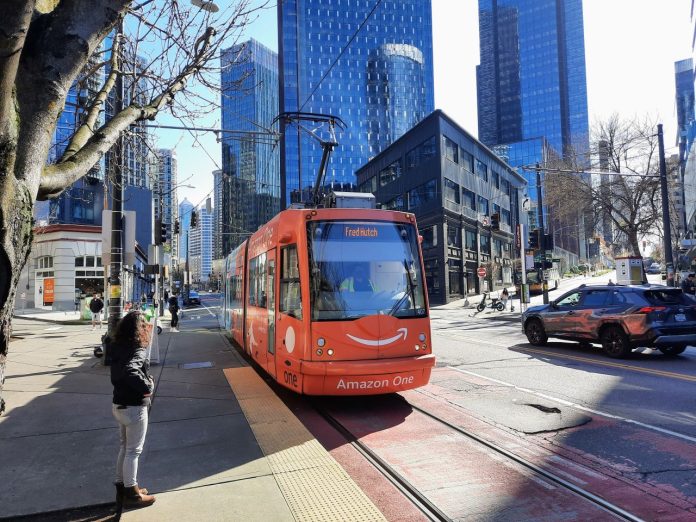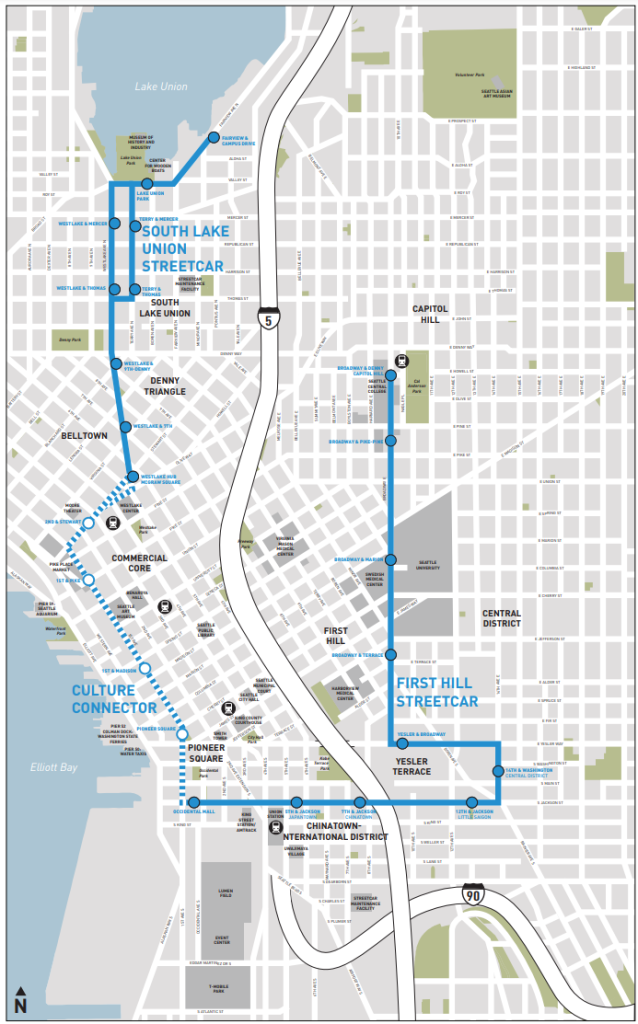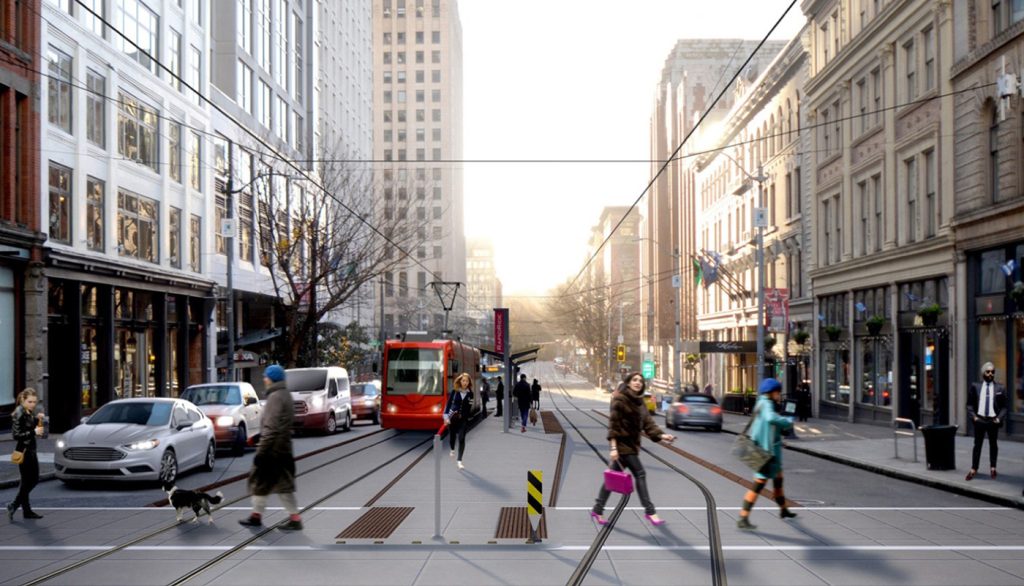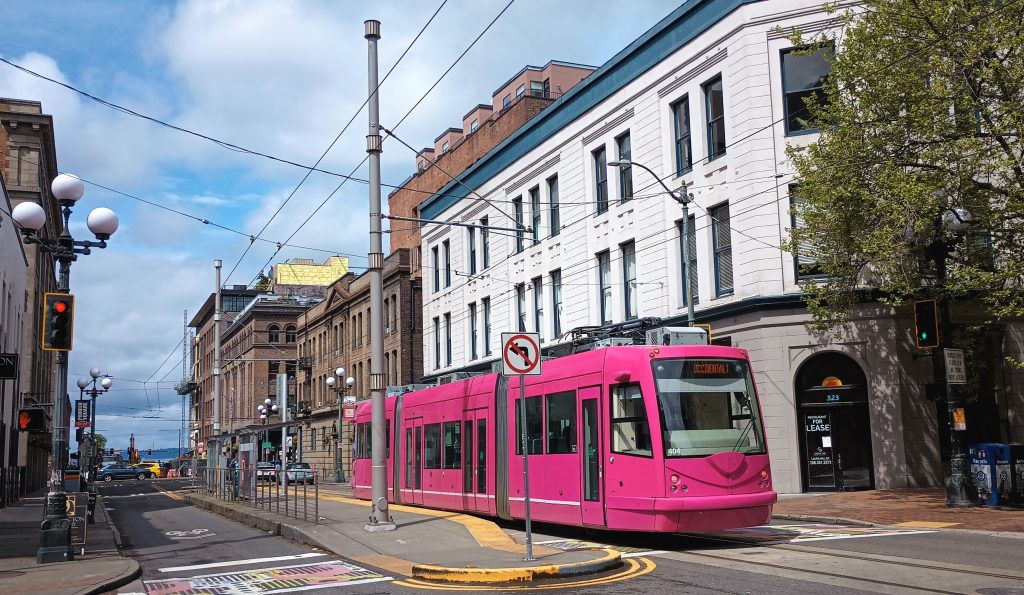
Councilmember Rob Saka’s budget amendment seeking a plan to decommission the South Lake Union Streetcar line went down in flames late last week, signaling broad support on the Seattle City Council to keep the 1.3-mile line going. But with approval of another amendment opposing the Cultural Connector streetcar on First Avenue, the long-stalled project that would finally connect the city’s two disconnected lines, the future of the Seattle Streetcar network is murky. Contradicting viewpoints surfaced during council deliberations on the topic.
The South Lake Union (SLU) Streetcar has been in service since 2007 — Seattle’s first modern streetcar since the city dismantled its extensive historic streetcar network in 1941, replacing many streetcar routes with trackless trolleybuses.
Saka’s amendment requesting the Seattle Department of Transportation (SDOT) develop a plan to “thoughtfully retire” the SLU streetcar was rejected on a 5-3 vote, with an abstention from outgoing Councilmember Tanya Woo. That was even after Saka introduced substitute language that seemed intended to make the idea more palatable to his colleagues. Put forward at the last minute, the full text is still not available on the city’s website.
However, Saka described the updated language as clarifying that service on the SLU streetcar would be maintained through the 2026 FIFA World Cup and in coordination with return-to-work policies at Amazon, which is returning to a full five-day workweek at its Downtown Seattle campus in early 2025. In the end, just Saka, Bob Kettle, and Cathy Moore supported the amendment.
Introduced just 24 hours before the final public hearing on the proposed city budget, Saka’s amendment nonetheless brought out transit advocates and downtown business interests who don’t want to see the streetcar decommissioned. In just a few days, an action alert put out by Seattle Subway garnered close to 1,000 signatures. Vulcan Real Estate, which had a large role in seeing the streetcar become reality, came out strongly against the proposal, along with the Downtown Seattle Association. Vulcan is a major property owner along the streetcar route.

With very low ridership and operating costs that continue to require direct city subsidy, the future of the South Lake Union Streetcar is still very much in doubt, and last week’s vote likely won’t be the end of the discussion. The consensus among transit advocates on the best way to increase ridership is to extend it and finally connect the SLU Streetcar with the First Hill Streetcar, providing more connectivity while at the same time increasing access to high demand amenities like Pike Place Market and the Seattle Art Museum.
That extension, the so-called Culture Connector line (previously called the Center City Connector), has been in limbo since former Mayor Jenny Durkan put it on hold by in 2018. First Avenue utility work was already underway at the time. Durkan ultimately affirmed support for the streetcar extension after a year of scrutinizing the plan, but made no moves to secure full funding, nor did her successor Bruce Harrell.
While stuck in limbo, expected costs have more the doubled; the project’s most recent estimate was $410 million dollars, according to a report issued earlier this year. In 2018, the City had put the cost around $200 million. Given Seattle’s budget crisis, the project is effectively on life support.
By a 7-1 vote, the Seattle City Council doubled down on opposition to the streetcar extension, approving a Kettle amendment that removes reference to the Culture Connector’s unsecured $410 million from the city’s Capitol Improvement Program (CIP). While a largely symbolic move, it does signal a lack of support for the fully-designed line. Maritza Rivera was the lone vote in opposition, with Tammy Morales abstaining.
A staff report notes an expectation that, if approved by council, the amendment would push the Harrell Administration “to resolve any outstanding grant obligations related to the project, propose the abandonment of existing capital appropriations for the project in separate legislation, and work towards removing the Culture Connector from the CIP.”
In other words, within the span of a few minutes, the Council voted to support the South Lake Union Streetcar and to oppose the most likely path toward a unified system that would ensure the streetcar’s long-term success and solvency. Instead, Kettle, Saka and budget chair Dan Strauss were interested in discussing a brand new concept for a streetcar on Third Avenue, a proposal that seemed to come out of thin air. Kettle first mentioned the idea for a Third Avenue streetcar earlier in the week.
“We need a rethinking on the core design assumptions, we need a rethinking of the options — perhaps Third Avenue… as you know, Third Avenue has only one way to go, and that’s up,” Kettle said. “Bottom line is that this is a zombie project, and sadly, to quote the quotable quote on this, the First Avenue streetcar is really no way to run a railroad.”

A substantial overhaul of Third Avenue has been a longtime priority of the Downtown Seattle Association and other downtown business groups. But a streetcar has never been part of any of the proposals put forward so far. And yet budget chair Dan Strauss said that was the deciding factor in his vote Friday.
“With that information that it is still on the table to put the train up Third Avenue, I will be supporting this motion today,” Strauss told his colleagues.
Routing an extension of the First Hill Streetcar on Jackson Street onto Third Avenue would almost certainly present major technical challenges, and involve abandoning the current streetcar stop serving Pioneer Square at Occidental Street. Construction would disrupt the region’s busiest bus artery. Then there’s the issue of the existing infrastructure for the Sound Transit light rail tunnel underneath Third, sure to present certain unique challenges. But ultimately, it’s just not clear why Third Avenue needs a streetcar if First Avenue does not.
Kettle’s primary arguments against the Culture Connector was that the project was extracting “opportunity costs” and would negatively impact motorists, particularly by restricting left turns on First Avenue.

“We could have already had a great, unique bus service along First Avenue, connecting Seattle Center and the stadiums, with Pioneer Square and the Pike Place Market, but we don’t, because the zombie project has basically took that out,” Kettle said. “Not to mention road improvements in Pioneer Square, which are important. And we just did a bunch as related to the Alaskan Way Project. And we had opportunities as work was being done into Pioneer Square and other parts along [with] the ways we’re trying to connect the waterfront better to downtown, to do some of this work. But it wasn’t done.”
Kettle’s speech includes some revisionist history. First Avenue has been absent of most Metro bus routes since 2011, before the idea of a streetcar there was being seriously considered, due to impending construction on elements of the Alaskan Way Viaduct replacement project. With intermittent closures planned for streets along the waterfront, Metro didn’t want to have to keep moving buses from one street to another. And moving all buses onto Third Avenue brought ease of transfers, along with reliability benefits given full bus priority on the corridor.
Since then, there’s been little push to return buses to First Avenue, though Metro has been exploring ways to serve areas currently left out, particularly in the northern section of Belltown (where the streetcar would not run). The City has also contributed to the operation of a free waterfront shuttle during the summer months.
As far as street improvements in Pioneer Square, it’s unclear what upgrades Kettle thinks went unfunded beyond the $21 million overhaul of the east-west streets in the neighborhood currently underway right now. The construction of the Culture Connector would require a $51 million upgrade to the “areaways” in the neighborhood, the hollow passageways underneath the sidewalks that resulted when the street level was raised in the late 1900s. Those upgrades all likely need to happen at some point to withstand normal traffic, but the $1.55 billion transportation levy just approved by voters only includes $3 million for that work.
Saka, quoting the Seattle Bike Blog, called keeping the South Lake Union streetcar in place a “classic case of Seattle indecision.” But ultimately the votes Friday illustrate that the Council is doubling down on that indecision, ready to side with downtown business groups when it comes to the South Lake Union Streetcar but also seemingly ready to pursue unstudied options like a Third Avenue streetcar over plans that have been on the books for years. That indecision seems set to continue into the foreseeable future.
Ryan Packer has been writing for The Urbanist since 2015, and currently reports full-time as Contributing Editor. Their beats are transportation, land use, public space, traffic safety, and obscure community meetings. Packer has also reported for other regional outlets including Capitol Hill Seattle, BikePortland, Seattle Met, and PubliCola. They live in the Capitol Hill neighborhood of Seattle.


